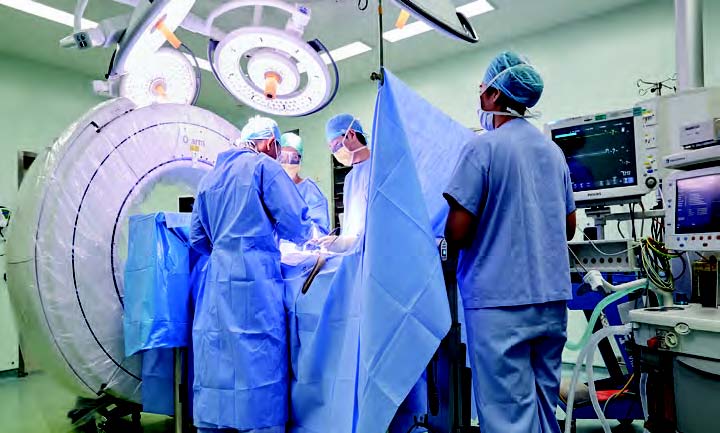
A mock-up of a spine procedure using an advanced imaging system, known as the O-arm, to guide surgeons.
Staffed by general surgeons in the early days, the discipline is now highly specialised, with surgeons operating in seven areas, such as spine, sports medicine, and musculoskeletal tumours.
 The development of orthopaedic surgery in Singapore mirrors closely that of the US and UK. Before World War II (1939-1945) and up to the early 1950s, orthopaedic conditions were managed by general surgeons with an interest in musculoskeletal trauma and fractures. No systematic or structured programmes were
The development of orthopaedic surgery in Singapore mirrors closely that of the US and UK. Before World War II (1939-1945) and up to the early 1950s, orthopaedic conditions were managed by general surgeons with an interest in musculoskeletal trauma and fractures. No systematic or structured programmes were
available, and equipment and instruments were crude.
It was only in 1951 that the practice was established as a separate clinical entity, and five years later in 1956 that the Department of Orthopaedic Surgery came into being. The first batch of local orthopaedic surgeons were trained in the 1950s, undergoing basic clinical training before proceeding to Britain for a postgraduate degree in the discipline.
In the 1950s, poliomyelitis was rampant, affecting many young children. Orthopaedic surgeons were involved in their rehabilitation, as doctors generally did not want to be involved in treating the disease and others such as tuberculosis, osteomyelitis, septic arthritis, and crippled children. In those days, orthopaedic surgeons also took charge of chronic ulcers and hand deformities in leprosy.
The department started to grow in stature and eminence after the late Professor N Balachandran took over in 1980. He spearheaded several service improvements for people with disabilities, spinal injuries, chronic sickness, and congenital deformities. He was also involved in setting up orthopaedic surgery departments in other hospitals, including Tan Tock Seng Hospital, Alexandra Hospital, and the now-defunct Toa Payoh Hospital, playing a crucial role in improving the practice in Singapore.
Teaching, research
Importantly, Prof Bala placed great emphasis on teaching and training the next generation of specialists so that patients could benefit from better care. That legacy continues today. Not only is SGH’s Department of Orthopaedic Surgery the oldest in Singapore, it is today the largest and most established orthopaedic department in the country. It boasts seven orthopaedic subspecialties,
oncluding spine, adult reconstruction, sports medicine, trauma, musculoskeletal tumour, foot and ankle, and acute care. Two subspecialties have also been spun off into full departments in recent years — Hand and Reconstructive Microsurgery, and Plastic, Reconstruction and Aesthetic Surgery.
The department is at the forefront of research and innovative processes, harnessing technology and partnering leading biomedical companies to improve patient care. The department’s specialists have been quick to introduce and adopt new technologies in orthopaedics, such as artificial intelligence and 3D printing, scoring many firsts in the country and region. Not surprisingly, the department is recognised as the leading centre for minimally invasive orthopaedic and robotic surgery.
Indeed, given its size as well as the breadth and depth of its clinical services and experience, the department is well placed to lead in using such technology responsibly. Through well-designed clinical
pathways and care integration, it is the only orthopaedic department internationally to offer a unique suite of clinically audited presurgery, surgery, and post-surgery care programmes.
A recent initiative is the same-day discharge for some hip replacement patients, which cuts short a typically three-to-four day hospital stay and lowers costs for patients. More of such short-stay procedures are expected to become available, benefitting patients undergoing other orthopaedic procedures. The department sees up to a quarter of Singapore’s orthopaedic patients, handles more than 126,000 outpatient visits a year, and performs over 8,000 surgeries annually.













 Get it on Google Play
Get it on Google Play